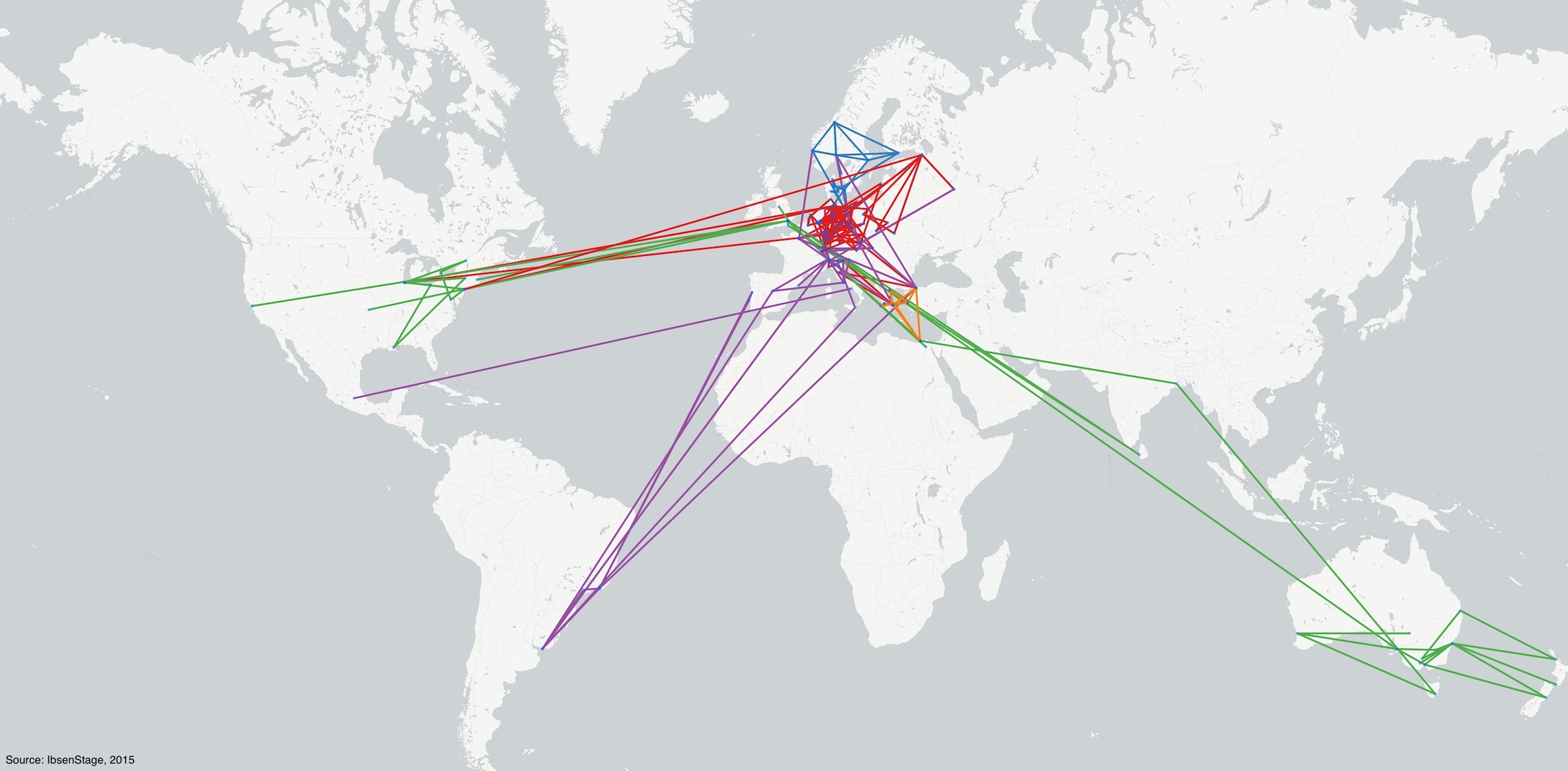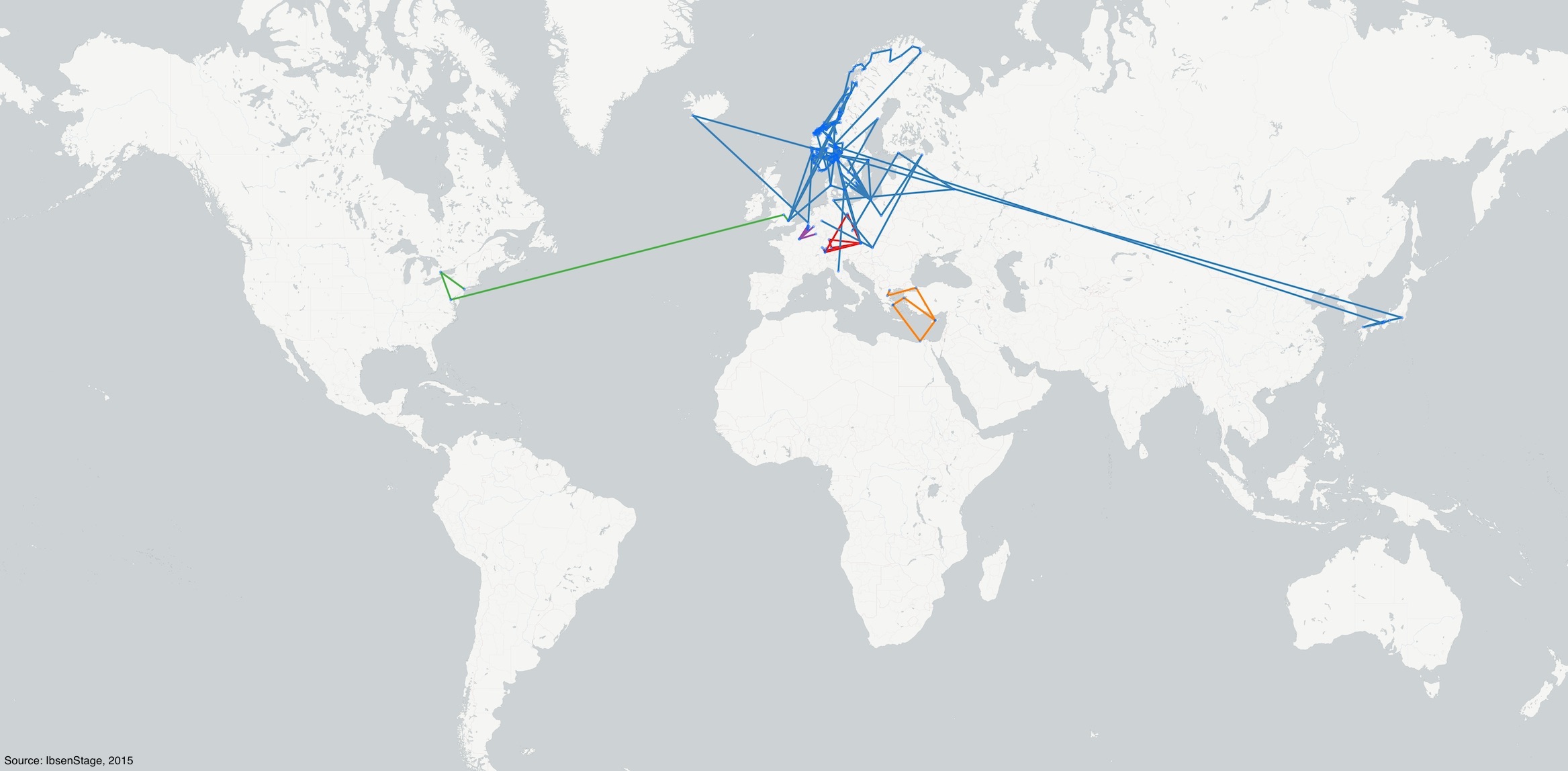Global Tours
The First Global Expansion
At the end of the nineteenth and beginning of the twentieth century, fourteen major European theatre companies toured the play internationally. These tours covered thirty-five countries and five continents. The play was performed in eleven languages. The artists’ trajectories artists marked on this map start with the first performance of the play in 1879 and continue until 1930. However, the major years of global expansion fall between 1889 and 1916.
This map shows the trajectories of the following artists from 1879 to 1930: Agnes Sorma (427367), Thessa Klinkhammer (439040), Irene Triesch (427219), Auguste Prasch Grevenberg (437638), Lilli Petri (432284), Gabriela Zapolska (434385), Johanne Dybwad (428957), Betty Hennings (427226), Janet Achurch (427547), Alla Nazimova (427384), Suzanne Després (428830), Teresa Mariani (441260), Teresa-Mariani Zampieri (434718), Emma Gramatica (429579), Eleonora Duse (428954), Lucinda Simões (433221), Kyveli Adrianou (448958), Ве́ра-Фё́доровна Комиссарже́вская (449852), and Matsui Sumako (431469).

Looking Inwards
After the first global dissemination of the play, there was comparatively little international touring of Et dukkehjem until the middle of the twentieth century. This map shows the trajectories of the three most significant tours during the period from 1916 to 1954: Tore Segelcke (434592), Ludmilla Pitoëff (432342), and Else Bassermann (427210).

Scandinavian Global Tours
From the middle to the late twentieth century, a new wave of global touring emerged that was dominated by artists from Scandinavia, particularly Norway. This wave emerges out of extensive national tours in the post-war period, before the productions moved south into thirteen European countries, and beyond the continent to East Asia. A small number of tours originating in other parts of Europe are also marked on the map.
This map shows the trajectories of the following artists from 1942 to 1991: Monna Tandberg (433624), Liv Strømsted (434647), Ingerid Vardund (433902), Marit-Synnøve Berg (434705), Marit Østbye (433400), Lena Granhagen (429585), Pernilla Östergren (432113), Eleni Lampeti (463613), Katerina Andreadi (462666), Vaso Manolidou (458999), Claire Bloom (426940), Maria Schell (432944), Käthe Gold (429525), and Janine Patrick (432212).

The Second Global Expansion
A second global expansion of tours of Et dukkehjem emerged at the turn of the twentieth and twenty-first centuries. These tours exceeded the boundaries of the first global wave and German and English were the dominant languages of performance. There were additional touring productions that originated outside Europe, particularly in the Americas, and East and South Asia.
This map shows the trajectories of the following artists from 1992 to 2014: Thea E. Skallevoid (438859), Anneke von der Lippe (434624), Juni Dahr (428731), Trine Appel (434640), Anne Tismer (433724), Manja Kuhl (437373), Susanne Wolff (434293), Maude Mitchell (431676), Anne-Marie Duff (428936), Rebecca Rodgers (432693), Hattie Morahan (466047), Sophie Thursfield (433706), Mbumba Mbewe (431501), Abanti Chakraborty (464693), Jolente De Keersmaeker (456807), María Figueras (439065), Keja Klaasje Kwestro (466034), Maja Izetbegović (464883), Nisha Sharma Pokharel (435570), Reijiro Tsumura (433816), Nora Amin (438835), and Bettina Ezbidi (464740).
